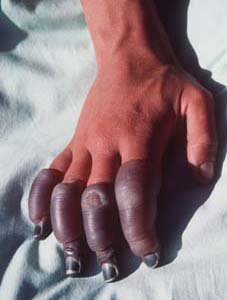Frostbite - symptoms and treatment

Frostbite - Damage to the SKIN that results from prolonged exposure to extremely cold temperatures. Frostbite occurs when the fluid in cells crystallizes into ice, causing the skin and often the underlying tissues to freeze. The fingers, hands, toes, feet, NOSE, and ears are most vulnerable to frostbite. People who have impaired peripheral circulation are at increased risk. Frostbite also can damage blood vessels, interrupting the blood supply. When this occurs, GANGRENE (tissue death) and subsequent loss of the body part are significant threats.
Symptoms of Frostbite and Diagnostic Path
Any loss of feeling following extended exposure to the cold raises suspicion of frostbite and is the first factor to consider when evaluating potential frostbite. The ice crystals that form cause the skin to become hard, pallid, and cold to the touch. There is loss of feeling and function, and the skin may BLISTER. Skin that has remained frostbitten for a long time may already be gangrenous or necrotic (blackened and dead). As it warms, frostbitten skin turns red and BURNS or hurts, sometimes severely.
Frostbite Treatment Options and Outlook
Prompt treatment is essential to save the affected tissue and body parts. When possible, a doctor should evaluate the situation and implement warming procedures for maximum recovery. To protect body parts until the person receives medical treatment, wrap them in sterile bandages (separating the fingers and toes, if affected). When immediate medical attention is not possible, warming the frostbitten areas should only be undertaken when they cannot refreeze.
Refreezing does more damage than allowing the area to remain frozen. Do not thaw frostbite unless the area can remain warm.
To warm frostbite, place the affected parts under gently running warm water for 20 to 30 minutes. The water temperature should be 8º to 10ºF above normal body temperature or about 108ºF, which feels warm but not hot to someone whose skin temperature is normal. For frostbitten ears, cheeks, or nose, apply cloths dipped in warm water. Do not use dry heat, as it will further damage the skin and tissues. Severe frostbite is likely better left for emergency care providers to treat because tissue damage is likely to be extensive.
The thawing process can be extremely painful, and may require PAIN relief medications. Superficial frostbite (first and second degree) usually heals with few or no residual consequences. Frostbite that extends deeper than the layers of the skin (third and fourth degree) can destroy MUSCLE, connective tissue, joints, and BONE, and may necessitate AMPUTATION or surgery to clean away necrotic tissue. A full damage assessment may not be possible for six to eight weeks, as it may take that long for tissue to demonstrate whether it will recover or die.
| Frostbite Severity | ||
|---|---|---|
| Degree of Damage | Characteristics | Recovery Implications |
| first degree | spots of whitened, hardened SKIN involving primarily the epidermis erythema (redness) of adjacent skin; localized edema (swelling) distorted or absent sense of touch or clumsy movements |
recovery with no residual complications |
| second degree | areas of whitened, hardened skin involving the epidermis and dermis erythema of adjacent skin; regional edema loss of feeling and movement fluid-filled blisters |
recovery with some residual complications (scarring) |
| third degree | white, hard skin with frostbite extending through the layers of the skin and into the subcutaneous tissue regional edema loss of feeling and movement blood-filled blisters |
recovery with moderate residual complications (tissue loss and scarring) |
| fourth degree | white, hard skin with frostbite extending through the skin and into supporting tissues and structures GANGRENE or necrosis; regional edema |
significant loss of tissue, with AMPUTATION likely |
Frostbite Risk Factors and Preventive Measures
People who spend extended time outdoors in cold weather, such as for employment or recreation, risk frostbite when exposure time extends beyond what clothing can protect. Wetness increases the risk. People who are very young or very old or who have DIABETES, PERIPHERAL VASCULAR DISEASE (PVD), RAYNAUD’S SYNDROME, untreated or undertreated HYPOTHYROIDISM, OR MALNUTRITION may develop frostbite far more rapidly and severely. Preventive measures include protective clothing appropriate for the weather conditions and limiting exposure when temperatures are extremely cold.
See also HYPOTHERMIA.
Open discussion on the topic Frostbite - symptoms and treatment
Similar interests
- Nuovi Casino
- Casinos Not On Gamstop
- UK Casinos Not On Gamstop
- Casinos Not On Gamstop
- UK Casinos Not On Gamstop
- Casino Non Aams Italia
- Slot Sites Not On Gamstop
- Meilleur Casino En Ligne
- Non Gamstop Casino Sites UK
- Meilleur Casino En Ligne
- Casino En Ligne France
- Best Non Gamstop Casinos
- Casinos Not On Gamstop
- UK Casino Not On Gamstop
- Casinos Not Signed Up To Gamstop
- Best Slot Sites UK
- Non Gamstop Casino Sites UK
- Online Casinos Nederland
- Online Casinos Nederland
- Casinos Not On Gamstop
- Best New Uk Casinos Not On Gamstop
- Casino Non Aams
- Non Gamstop Casinos UK
- Migliori Siti Casino Non Aams
- Bitcoin Casinos
- Sites De Paris Sportifs Belgique
- Bookmaker Non Aams
- Casino En Ligne